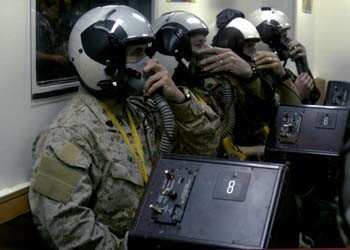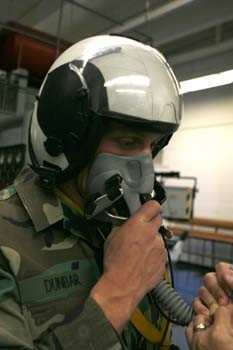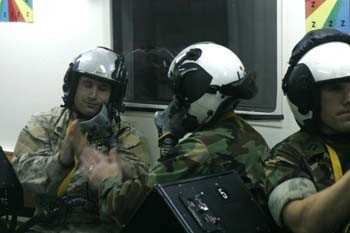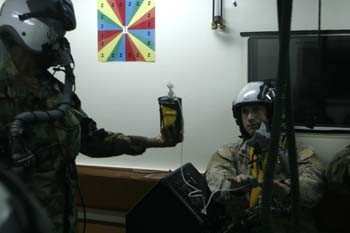Chamber At MCAS Miramar Simulates Low-Ox Environment
Some of the Navy and Marine Corps' toughest and stealthiest
fighters play patty cake when they come to California's Marine
Corps. Air Station Miramar, to train at the Aircraft Survival
Training Center.

Reconnaissance Marines along side Navy SEALs play this childhood
game in a simulation chamber that duplicates the conditions they
would endure in a hypoxic environment -- an environment lacking
oxygen.
 The training
familiarizes the service members with the way their bodies will
respond at high altitudes where high pressure reduces the
availability of oxygen.
The training
familiarizes the service members with the way their bodies will
respond at high altitudes where high pressure reduces the
availability of oxygen.
Before entering the hypoxic environment, trainees sit in the
chamber and breath 100-percent oxygen. This decreases the nitrogen
concentration in their blood and helps prevent decompression
sickness, Petty Officer 1st Class R. D. Nay, a corpsman at ASTC
explained.
During the training the students are taken to a simulated
altitude of 35,000 feet. The simulation represents the environment
the trainees will experience when parachuting from extreme
altitudes.
Once the service members reach 35,000 feet, the simulated drop
in pressure begins and students fall at a rate of 5,000 feet per
minute until they hit 25,000 feet. The drop in altitude effects the
pressure in the chamber and the trainees remove their masks
creating a controlled state of hypoxia.
As hypoxia takes over students lose the coordination and mental
function needed to complete the simplest tasks such as playing
patty cake with their neighbors or read color charts. As the time
pressed on and with the low-oxygen saturation, the skin of the
service members then began to turn blue and their motor skills
decreased drastically.
Hypoxia can cause a person to feel euphoric, turn blue and lose
the ability to perform simple actions. Often the individual
suffering the symptoms of hypoxia is unaware of their mental and
physical state. This can result in disaster in emergency situations
at high altitudes. With this in mind, instructors at the chamber
focus much of their training on teaching service members how to
identify and treat hypoxia early on.
"I felt like I was doing good for a while," said Petty Officer
2nd Class Richard Munoz, a SEAL student. "I didn't even realize I
was messed up until I tried focusing on the charts on the
wall."
After approximately four minutes with no oxygen, the students
descend to 18,000 feet to simulate night parachuting and navigating
in a hypoxic state.
The room goes black. The red glow of flashlights illuminates
darkness revealing small maps being held by shaking hands. The
students focus their efforts on steadying their hands and eyes to
properly identify a safe landing zone.
"There is a four-minute maximum that we can leave them without
oxygen," said Navy Lt. Cmdr. Rebecca Bates, director, ASTC.
"Between three and five minutes the service members become too
impaired to treat themselves."
The goal is to train them to identify and self-treat hypoxia in
the event they find themselves in an emergency situation at high
altitudes, explained Bates. The strictly monitored time limit
ensures the trainees are familiar with their reaction to a lack of
oxygen, but not injured by the training.

"We want them all to feel the hypoxic symptoms, explained Bates.
"The symptoms are not always the same so some people react
different."
It's not until the oxygen masks return to the faces of the
trainees that their eyes lose their dopey glaze and the service
members regain control of their limbs. With the oxygen flowing
again, a light goes on in the minds of the students as they realize
the significance of this often comical, yet potentially lifesaving
training.
"It was some good training and I learned a lot," said Munoz. "At
first, it was a bit scary. Once we got used to the feeling our
class room knowledge kicked in. This training will help out with
situational awareness when it is the real deal.

The ASTC at Miramar is one of two in California. The other at
Naval Air Station Lamoore, houses up to 4,000 students per year for
various types of aviation survival training.
(ANN salutes Lance Cpl. George J. Papastrat, MCAS
Miramar)
 ANN's Daily Aero-Linx (04.16.24)
ANN's Daily Aero-Linx (04.16.24) Aero-News: Quote of the Day (04.16.24)
Aero-News: Quote of the Day (04.16.24) Airborne 04.10.24: SnF24!, A50 Heritage Reveal, HeliCycle!, Montaer MC-01
Airborne 04.10.24: SnF24!, A50 Heritage Reveal, HeliCycle!, Montaer MC-01 Airborne 04.12.24: SnF24!, G100UL Is Here, Holy Micro, Plane Tags
Airborne 04.12.24: SnF24!, G100UL Is Here, Holy Micro, Plane Tags Airborne-Flight Training 04.17.24: Feds Need Controllers, Spirit Delay, Redbird
Airborne-Flight Training 04.17.24: Feds Need Controllers, Spirit Delay, Redbird






